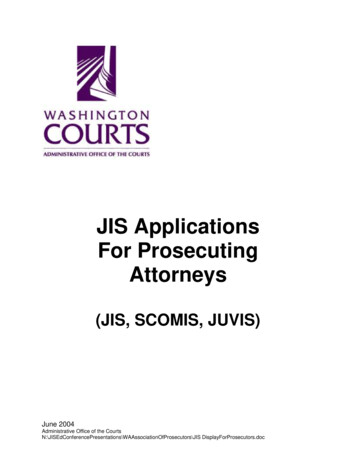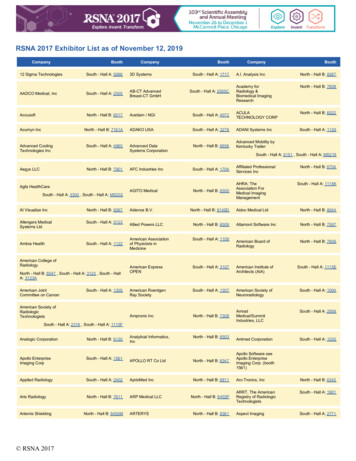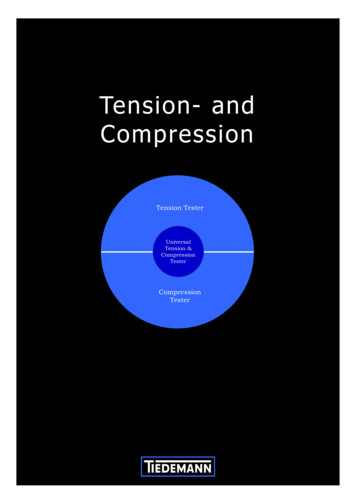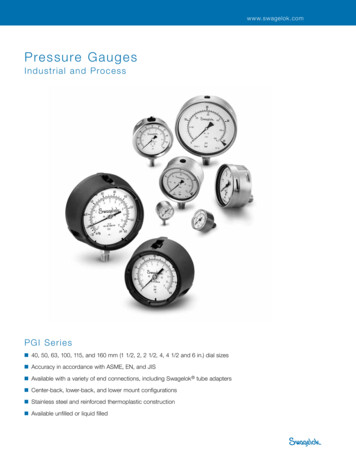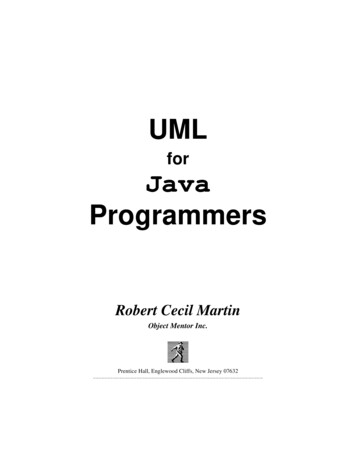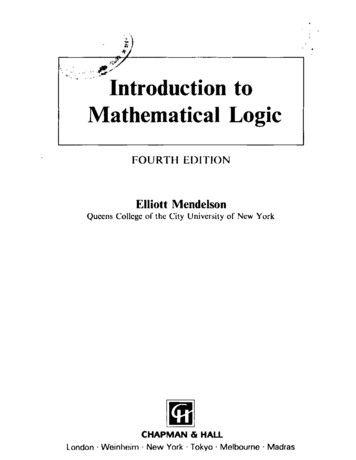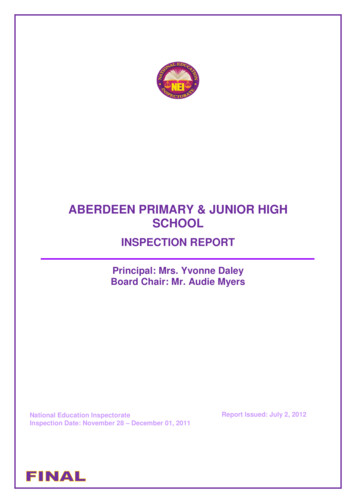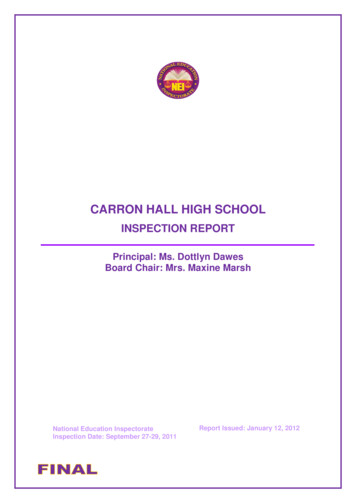
Transcription
CARRON HALL HIGH SCHOOLINSPECTION REPORTPrincipal: Ms. Dottlyn DawesBoard Chair: Mrs. Maxine MarshNational Education InspectorateInspection Date: September 27-29, 2011Report Issued: January 12, 2012
TABLE OF CONTENTSPageIntroduction . 1Key Questions . 1The Five-point Scale . 2Consistency in terminology . 2Profile . 3School’s Demographics . 3Socio-economic Context . 3Executive Summary . 4Overall effectiveness of the school . 4Findings of School Inspection . 61) School Leadership and Management . 62) Teaching Support for Learning . 83) Students’ Academic Performance . 104) Students’ Academic Progress . 115) Students’ Personal and Social Development. 126) Use of Human and Material Resources . 137) Curriculum and Enhancement Programmes. 158) Student Safety, Security, Health and Wellbeing . 16RECOMMENDATIONS . 18Further Action . 19List of Abbreviations and Acronyms . 20Appendices . 21Appendix 1 - Record of Inspection Activities . 22Appendix 2 - Inspection Indicators. 23Appendix 3 - National Test Data . 42iiNational Education Inspectorate May 2013School Inspection Report
IntroductionThe National Education Inspectorate (NEI) is responsible for making an assessment of thestandards attained by the students in our primary and secondary schools at key pointsduring their education. It is the aim of the NEI to report on how well students perform orimprove, as they progress through their schooling and learning life. The NEI is also chargedwith the responsibility to make recommendations to support improvement in the quality of theprovision and outcomes for all learners.During school inspections, our trained inspectors observe classroom lessons, interviewmembers of the school’s staff, students individually and in small groups. Inspectors also lookat samples of student work and study various school documents provided before and duringthe inspection. Additionally, School Inspectors hold meetings with the principal and seniormembers of the staff to get clarity on their roles and responsibilities at the school.Please see the Inspection Indicators (Appendix 2) used by School Inspectors to assist informing judgements about a school’s progress.Key QuestionsThe inspection indicators are structured as a set of eight key questions that inspectors askabout the educational provision and performance of every school. These are:1. How effectively is the school led and managed by the Board, the principal and seniormanagement team and middle leadership?2. How effectively does the teaching support the students learning?3. How well do students perform in national and/or regional tests and assessments?(For infants: in relation to age-related expectations)4. How much progress do students make in relation to their starting points?5. How good is the students personal and social development?6. How effectively does the school use the human and material resources at its disposalto help the students achieve as well as they can?7. How well do the curriculum and any enhancement programmes meet the needs ofthe students?8. How well does the school ensure everyone’s security, health, safety and wellbeing?1National Education Inspectorate May 2013School Inspection Report
The Five-point ScaleInspectors make judgements according to a five-point scale. The five levels on the scale aredefined as follows:Level 5– Exceptionally high quality of performance or provisionLevel 4– Good. The expected level for every school. Achieving this level in allaspects of its performance and provision should be a realistic goal for everyschoolLevel 3– Satisfactory: the minimum level of acceptability required. All key aspects ofperformance and provision in every school should reach or exceed this levelLevel 2– Unsatisfactory: quality not yet at the level acceptable for schools. Schoolsare expected to take urgent measures to improve the quality of any aspect oftheir performance or provision that is judged at this level. Action on theinspectors’ recommendations for improvement is mandatoryLevel 1– Needs Immediate Support: quality is very low. Schools are expected to takeimmediate action to improve the quality of any aspect of their performance orprovision that is judged at this level. Action on the inspectors’recommendations for improvement is mandatory.Consistency in terminologyThe following terms are used consistently throughout the indicators with the followingdefinitions:AllAlmost allMostManySomeFewNone100%90% to 99%75% to 89%50% to 74%21% to 49%1% to 20%02National Education Inspectorate May 2013School Inspection Report
ProfileSchool’s DemographicsSchool Name:Locale:Parish:Region:Gender:School Code:School Organization:Size:Attendance Rate:Capacity:Enrolment:No. of Teachers:Pupil-Teacher Ratio:Owned By:School Board:Carron Hall High SchoolRuralSt. Mary2Co-educational05080Whole DayClass I86%6005213119:1GovernmentActiveSocio-economic ContextCarron Hall High School is a government owned institution founded in 1922 by thePresbyterian Church as a home for girls. It was handed over to the government in 1938 andwas used as a practical training centre. This institution has undergone several changessince 1938; most famous is the boarding institution, the Carron Hall Vocational Centre forgirls, focusing mainly on areas of home management, home economics and catering skills.In more recent times it was changed from a vocational school to the Carron Hall High schoolfor boys and girls and boarding was terminated.The main economic activities of the parents and guardians of the students are agricultureand tourism; a few parents are employed in the nearby town of Ocho Rios, approximatelyfifty kilometres to the west of the community. Unemployment is widespread particularlyamong the women in the surrounding communities. Most students are from the immediateenvirons and some are from areas such as Port Maria and High Gate. There are twohundred and ninety five students (57% of the population) on the PATH programme. Theschool provides hot meals each day and a tuck shop offers a variety of snacks.School Satisfaction SurveyThe National Education Inspectorate (NEI), as part of its inspection process, analysedresponses to questionnaires issued to a sample of parents, teachers and students. Eightyeight (88) parents, 220 students and all 23 teachers returned completed questionnaires.Most (95%) parents say that teaching is good and that their children are encouraged to learnand make good progress. Many say that the school is led and managed well but 35 per centdisagreed as well while others choose not to answer the question. Eighty-eight per cent donot agree that the students behave well. Many (33%) students say it is a good school, theyenjoy their lessons and they are well treated by teachers. Almost 85% disagree that studentsbehave well and are kind to each other. Many teachers (51%) agree that leadership makesinstructional effectiveness top priority and is shared.3National Education Inspectorate May 2013School Inspection Report
Executive SummaryOverall effectiveness of the schoolThe overall effectiveness of Carron Hall High School is unsatisfactoryLeadership and management are unsatisfactoryOverall management in the school is unreliable and there are obvious weaknesses in theadministrative aspects of the institution. Middle management does not offer effectivemonitoring in supporting the management structure in the school. Self-evaluation isinadequately developed and is not used to reflect on the teaching and learning process; as aresult, it has no significant impact on improving academic performance. The Board, despiteits efforts, has little influence on the effective management of the school. Even though thereis a satisfactory relationship with parents, support in the teaching and learning process islacking.Teaching and learning is unsatisfactoryWhile teachers have adequate subject knowledge, they rarely reflect on their teaching. Mostdo not evaluate the lessons they teach to ascertain the impact on the students. Methodsused to deliver lessons are general and do not cater to the varying abilities of the students.Assessment is poorly developed and the test results provide adequate information on theprogress of individual students. As a result, learning is limited; in many cases performance isbelow grade level and very little application of learning to new and real life situations.Performance in English and mathematics needs immediate supportStudents perform poorly in national exams. Most students perform well below nationalaverages consistently in both English and mathematics.Progress in English and mathematics is unsatisfactoryStudents’ performance is low and they make very little progress. In fact, there is a declinefrom their starting points to their exit at Grade 11 in both English and mathematics.Overall, students’ personal and social development is unsatisfactoryBehaviour and attitudes overall are unsatisfactory; indiscipline and unpunctuality are majorconcerns among the student population. Many students show satisfactory awareness ofeconomic situations and a good understanding of environmental issues.The school’s use of its human and material resources is satisfactoryThe academic staff is suitably qualified and there are adequate teaching and support staff todeliver the curriculum. Material resources are inadequate but those present are of goodquality. However, some resources are under-utilized and therefore do not effectivelyenhance students’ learning and progress.4National Education Inspectorate May 2013School Inspection Report
Curriculum and enhancement programmes are unsatisfactoryThere is limited modification of the curriculum and the less able students do not benefitgreatly from the offerings. While there are some enhancement components in thecurriculum, the programmes catering to students’ overall development are limited.Provisions for safety, security, health and wellbeing are unsatisfactoryWhile there is monitoring at the main gate, the school campus is wide open and providesfree access to all. Students have to navigate a rugged terrain to transition from one area tothe next. Students’ wellbeing is well catered for. There is a Guidance Counselor whomonitors the Programme of Advancement through Health and Education (PATH) from whichmany students benefit. However there is no school nurse and members of staff provideassistance in the absence of a policy governing wellbeing.Inspectors identified the following key strengths in the work of the school: Students’ nutritional needs are met through preparation of well balanced meals forthe studentsStudent teacher ratio is low and so classes are small and manageableAdequate classroom spaceGood staff relationships among staffHow effective is the school overall?The overall effectiveness of the school is unsatisfactory5National Education Inspectorate May 2013School Inspection Report
Findings of School Inspection1) School Leadership and ManagementHow effectively is the school led and managed by the Board, the principal andsenior management team and middle leadership?Overall, the school is unsatisfactorily led and managedSchool-based leadership and management are unsatisfactoryThe Principal is sociable and has a good working relationship with the staff. She has aninterest in the development of the school and encourages staff and students to do well. Hervision for the school is to foster a culture of excellence, which includes awareness of theimportance of the environment and good social graces. This vision however is notadequately shared and translated into the school’s culture, and efforts placed on makingnecessary changes to achieve this goal are insufficient.In general, the leadership of Carron Hall High School is ineffective and this is manifested inthe gaps in the manner in which senior management carry out their duties. There is noformal accountability system in place for activities such as lesson planning and the directsupervision of instruction; for example Heads of Departments are unsure which teachersshould present lesson plans to them for monitoring. At best, the system in place is poorlyorganised. Detailed plans are made prior to the commencement of the academic year andthese are shared with the academic staff. However, no proper implementation, monitoring oraccountability systems are in place after the initial planning and a laissez-faire systemdevelops. Teachers are not held to account for the lack of progress that students’ make andlittle consideration is given to students’ academic development. Though it is clearly stated inthe School Improvement Plan that the majority of the students who enter the school arereading below their grade level, no differentiation is seen in most lessons and lesson plansobserved.Self-evaluation and school improvement planning are unsatisfactoryThe school’s self-evaluation team includes the Senior Management Team (SMT) and a fewteachers but does not include the Board, parents or students. A survey of the parents’ viewsshow that 65 per cent of them think that students at the school do not behave well; thePrincipal is not aware of this view. Through limited self-evaluation, leaders have theopportunity to understand the strengths and weaknesses of the school. However, littleprovision is made for the strategic development of the areas of weakness using what data isavailable. For example, though there is a pull out programme for reading and mathematics,and the streaming of students there is inadequate tracking of the success of these initiatives.These same students are then placed in classes where reading is not reinforced and theyare exposed the same content under the same conditions as the more able students. Veryfew diagnostic records are available as little diagnostic testing is done to assess the level ofstudents’ weaknesses even though the school admits that the majority of the students areweak.Self-evaluation is not well developed, as accountability systems are poor. Staff appraisalsare done and the findings inform plans for staff development through workshops but littlefollow up is done to ensure that teachers implement what they learn; monitoring of the6National Education Inspectorate May 2013School Inspection Report
teachers’ performance is underdeveloped in the school.Governance is unsatisfactoryThe Board has little influence on the work of the school, as the system of communication isinadequate; little consultation is made before actions are undertaken at the school. Boardmembers are relatively uninformed about many programmes in the school and there is noformal system in place to ensure that they are made aware of the operations of the school.Although the Board is presented with the school’s performance in national tests, it does notset targets for development and where directives are issued; there is no formal system ofaccountability in place to ensure that they are followed. The Board is not involved in theschool’s self-evaluation process and spends considerable time seeking clarifications onoperational matters; many requests of the Principal have not been forth coming. The Boarddoes not keenly monitor financial issues and there is an over reliance on the Principal toreport on the financial status of the school.Relationship with parents and local community is satisfactoryThe school communicates well with parents using various means such as circulars,telephone calls and academic report cards. Parents are able to keep track of their children’sprogress as much as is recorded by teachers as well as to hold discussions with them abouttheir children’s progress. A number of workshops are held for parents throughout the yearand they are encouraged to get involved in their children’s education. Links with localagencies yield a small income, which is used to enhance students’ wellbeing for example,students are assisted with examination fees and other needs. Overall parental supportregarding the functioning of the school and student learning is less than desirable.How effectively is the school led and managed by the Board, the principal and seniormanagement team?7-11GradesSchool-based leadership and managementUnsatisfactorySelf-evaluation and improvement sfactoryRelations with parents and community7National Education Inspectorate May 2013School Inspection Report
2) Teaching Support for LearningHow effectively does the teaching support the students’ learning?Overall, teaching in support of learning is unsatisfactoryThe teachers’ knowledge of the subjects they teach and how best to teach it isunsatisfactoryMost teachers demonstrate solid knowledge of their content area through confident deliveryand the ability to answer challenging questions posed by students. For example, Grade 10English teacher has good command of the subject and this allows for the dissemination ofaccurate information. However, only a few demonstrate that they have knowledge of howbest to teach by using a variety of teaching and learning strategies to engage students in thelearning process. This was demonstrated by the Grade 11 Chemistry teacher who usedpower point presentations, experiments, group work and chalkboard activities to stimulatestudent learning. There is little evidence to suggest that teachers reflect on their teaching.Lesson plans seen do not indicate how students coped with the lessons taught and whatcorrective measures would be implemented in the next class.Teaching methods are unsatisfactoryWhere lesson plans are written, most are detailed with an easy to follow sequence ofobjectives, activities and assessment. However, they are not vetted and no meaningfulevaluation is done to inform future planning. In other instances, many teachers have nolesson plans and lessons lack variation in the strategies used as most tend to be teachercentred with little provisions for differentiated learning; this was noted mainly in Grades 7, 8and 10. The use of resources such as textbooks, audio and visual materials, ICT andresource persons is very minimal as most lessons use the ’chalk and talk’ method with littleprovision for interaction of teacher and students. One teacher’s attempt to integratetechnology was ineffective; one laptop computer was used to introduce the entire populationof a class of students to the computer. However, some teachers, especially in the uppergrades, make effective use of ICT equipment, textbooks, handouts and practical activitysheets to guide lessons. In the better lessons, these aids are coupled with effective use ofquestioning which spur vibrant classroom discussions and stimulate learning. Someteachers take the time to motivate the students during lessons. However, in many classes,there is little variation in teaching strategies by some teachers and students’ differences inlearning abilities are largely ignored.Students’ assessment is unsatisfactoryIn most instances, assessment is not well developed and most records do not providesatisfactory continuous data to determine the level of students’ progress and achievements;for example, there are gaps in student records particularly in Grade 9 internal examinationresults and in some teachers’ mark books. There is not much documentation to informstudents of their strengths and weaknesses; students’ workbooks do not reflect usefulcomments on their performance and progress to help them understand what they need to donext. However, in some instances, assessment as part of the teaching and learning processis satisfactory as some teachers use questions, chalkboard activities and seatwork toprovide feedback and determine students’ progress in class. In most lessons, students arenot provided with sufficient information or assistance in developing the skills of selfassessment and so many of them are unable to correct their own mistakes or guide theirown learning.8National Education Inspectorate May 2013School Inspection Report
Student learning is unsatisfactoryMany students display positive attitudes to their work and a willingness to attempt workgiven. In the best lessons, many students are able to explain what they have learned. Insome instances, group activities see students working collaboratively and assist each otherin the learning process. However, opportunities for application of learning to new situationsand real life are very limited. Students in some instances, particularly in upper school, arenot given the opportunity to develop inquiry skills, as the lessons are teacher centred. Forexample, students are read to and are required to write notes while they have their owntextbooks. Independent learning is not encouraged in some cases as some teachers eitherlack the capacity to manage the process of guided learning well or have little confidence inthe students’ abilities to learn the skill. In general, more students in the lower school are lessable to work independently but across the grades students usually do not use dictionaries oreven the textbooks to do research for answers to questions.How effectively does the teaching support the students learning?7-11GradesTeachers subject knowledge and how bestto teach the subjectUnsatisfactoryTeaching nts learningUnsatisfactory9National Education Inspectorate May 2013School Inspection Report
3) Students’ Academic PerformanceHow well do the students perform in national and/or regional tests andassessments?Overall, students’ performance in national tests needs immediate supportStudents’ performance in English needs immediate supportStudents’ performance in national exams in English is poor. Performance was consistentlybelow the national average over the period 2008 to 2010. In the three-year period, thestudents’ performance averaged 11 per cent in CSEC English while the national average forthe same period was 63 per cent. In 2008 the school average was 14.1 per cent. It remainedrelatively the same for the following year (14.8%) but rose significantly in 2010 when theaverage increased to 23.9 per cent. However it was forty-seven percentage points below thenational average.In preparing students for matriculation for tertiary education the students who attained five ormore subjects including English Language and mathematics averaged 2.1 per cent overthree years period under review as against the national average over the same period at19.6 per cent. The students’ average performance at 2.1 per cent compares unfavourablyagainst the targets set for the sector, which is 54 per cent of the students leaving high schoolmatriculating for tertiary studies.When comparing gender attainment, girls performed slightly better than boys in EnglishLanguage over the entire period.Students’ performance in mathematics needs immediate supportStudents’ performance in mathematics in national assessments is of great concern.Students consistently perform well below the national average in the subject over the lastthree years (2008-2010). An average of 31 per cent of the cohort sits the subject in nationalCSEC mathematics examinations. Over the three year period the students’ averageattainment was 5.7 per cent while the national average was 43 per cent. In 2008 the averagefor student passes was 6.52 per cent. This average declined the following year to 2.97 percent and gradually increased to 7.6 per cent in 2010; thirty-seven percentage points belowthe national average. Overall, like in English, girls outperform boys.How well do the students perform in national and/or regional tests and assessments?11GradesHow well do the students perform in National or regional testsand examinations in English?eNeeds Immediate SupportHow well do the students perform in National or regional testsand examinations in mathematics?lNeeds Immediate Support10National Education Inspectorate May 2013School Inspection Report
4) Students’ Academic ProgressHow much progress do the students make in relation to their starting points?Overall, students make unsatisfactory progress in relation to their startingpointsStudents’ progress in English is unsatisfactoryOver the last three years, the students enter Grade 7 at Carron Hall High School with GSATgrades in language arts far below the national average. The performance of the cohort thatentered the school in 2005 declined steadily from Grade 7 to 11. While the students enteredwith an average of 40 per cent signaling that many were ready for Grade 7 only 24 per centwere able to pass CSEC English five years after.A review of school documents indicate that the students perform much better during Term 1(September to December) than they do during the latter part of the school year: January toJune. In some instances however students either drop out of school or fail to report for theJune examinations. In lessons, many students struggle to complete work set at a low level.In Grade 8, some students were rewriting sentences substituting underlined words forsynonyms listed on the chalkboard and in Grade 10, some students were struggling toidentify parts of a sentence.Students’ progress in mathematics is unsatisfactoryWhile it is generally accepted that the students who enter Carron Hall High School areoperating below the national level in mathematics, the school has not done enough toensure the progress of the students. The overall GSAT intake average for students enteringCarron Hall High in 2005 was 38 per cent in mathematics. This was 15 percentage pointsbelow the national average of 53 per cent. In its self-evaluation, the school has recognizedthat mathematics is its weakest subject across all grade levels. The most recent CSECresults (2011) revealed that the school registered a 99 per cent failure in mathematics. In2008, the average for students’ passes in mathematics was 6.52 per cent. This averagedeclined in the following year to 2.97 per cent and gradually increased to 7.6 per cent in2010. This reveals a performance that is 37 percentage points below the national average.In lesson, progress is also slow. Grade 8 students were challenged as they calculated theareas of rectangles and squares while in Grade 9, some struggled to convert fractions todecimals. This limited progress continues to Grade 11, where many students had difficultyindicating values on a pie chart.How much progress do the students make, in relation to their starting points?7-11GradesHow much progress do the students make in relationship to theirstarting points in English?eUnsatisfactoryHow much progress do the students make in relationship to theirstarting points in mathematics?Unsatisfactory11National Education Inspectorate May 2013School Inspection Report
5) Students’ Personal and Social DevelopmentHow good is the students’ personal and social development?Overall students’ personal and social development is unsatisfactoryThe students’ behaviour and attitudes are unsatisfactoryWhile many students are able to control themselves and behave in age appropriate ways,the behaviour of some students, especially Grade 9 and a few Grades 10 and 11 boys isunacceptable both during lessons, as well as around the school. For example, students onthe Grade 9 block were observed in a stone throwing war, with little regard for the presenceof visitors and other students. During the lunch break, a few students bully others and pushthem to the ground; unconcerned about any injuries they may receive. While manystakeholders contend that indiscipline is a major concern for many staff members, less thanone-third of the students at the school are disruptive. In many classes, the students are wellbehaved, friendly to each other and respectful to their teachers. However, lack ofcommitment to learning by some students affect the use of instruction time as teachersfrequently pause lesson delivery to attend to the behavior of the few. A number of studentsseem unaware of how to conduct themselves in terms of their body language and seemunaware of how disrespectful this is to the adults.Punctuality and attendance needs immediate supportSome s
School Name: Carron Hall High School Locale: Rural Parish: St. Mary Region: 2 Gender: Co-educational School Code: 05080 School Organization: Whole Day Size: Class I Attendance Rate: 86% Capacity: 600 Enrolment: 521 No. of Teachers: 31 Pupil-Teacher Ratio: 19:1 Owned By: Government School Board: Active Socio-economic Context
